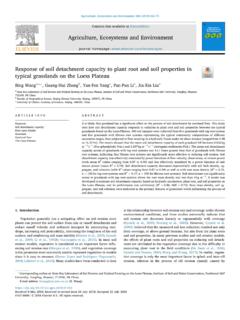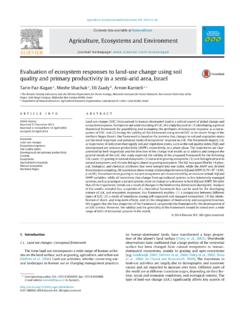Transcription of Agriculture, Ecosystems and Environment - Faculty Sites
1 agriculture , Ecosystems and Environment 177 (2013) 58 62 Contents lists available at SciVerse ScienceDirectAgriculture, Ecosystems and Environmentjo ur nal home p age: and field border effects on weed seed predation in thesoutheastern coastal plainAaron F. Foxa, S. Chris Reberg-Hortona, , David B. Orrb, Christopher E. Moormanc,Steven D. FrankbaNorth Carolina State University, Department of Crop Science, Campus Box 7620, Raleigh, NC, USAbNorth Carolina State University, Department of Entomology, Campus Box 7613, Raleigh, NC, USAcNorth Carolina State University, Fisheries, Wildlife, and Conservation Biology Program, Campus Box 8008, Raleigh, NC 27695, USAa r t i c l e i n f oArticle history:Received 2 November 2012 Received in revised form 11 June 2013 Accepted 12 June 2013 Keywords.
2 Weed seed predationHabitat managementCarabidaeSolenopsis invictaGryllusMicea b s t r a c tWeed seed predation was studied in nine organic crop fields (three each of maize, soybeans and hay; ha each) surrounded by four experimental field border types (planted native grass and prairieflowers, planted prairie flowers only, fallow vegetation, or mowed vegetation) during the fall of 2009and 2010 in eastern North Carolina. We used predator exclusion cages to determine the amount of weedseed removal caused by invertebrates and vertebrates. Three common agricultural weed species, red-root pigweed (Amaranthus retroflexus), broadleaf signalgrass (Urochloa platyphylla), and sicklepod (Sennaobtusifolia), were adhered to individual cards and placed inside the exclosure cages once a month for twoweeks.
3 Activity-density of invertebrate weed seed predators was measured with pitfall traps. Resultsshow that field border type had no effect on seed removal rates, but that crop type heavily influencedboth weed seed predation and invertebrate seed predator activity-density. Weed seed predation washighest in the dense, perennial hay fields and lowest in the more open harvested maize fields. Activity-densities for field crickets (Gryllus sp.) and the ground beetle Harpalus pennsylvanicus were also high inthe hay fields and low in the maize fields, while the red imported fire ant (Solenopsis invicta) seemed toprefer the open maize fields.
4 These results show that increasing vegetative diversity in field borders isnot always an effective method for conserving weed seed predators, but that higher quality habitat insidethe crop field can be achieved by increasing ground cover. 2013 Published by Elsevier IntroductionPreventing weed seeds from entering the soil is an impor-tant weed management strategy because the weed seedbank isthe main source of new weeds in agricultural fields. Increasesin the weed seedbank lead to greater management costs in sub-sequent seasons (Hartzler and Roth, 1993; Taylor and Hartzler,2000).
5 Westerman et al. (2003) found that post-dispersal weedseed predation in organic cereal fields accounts for greater lossesto seedbanks than aging, microbial decay or even disturbances likecultivation. Menalled et al. (2000) showed that fields adjacent tocomplex border vegetation experienced increased seed , other studies have been unable to replicate these results,possibly due to small plot sizes ( Kollmann and Bassin, 2001), Corresponding author at: Department of Crop Science, Campus Box 7620,Raleigh, NC 27695-7620, USA. Tel.: +1 919 515 7597; fax: +1 919 515 address: chris ( Reberg-Horton).
6 And it is not clear if increasing vegetative diversity in areas aroundcrop fields augments weed seed predation in all to more temperate areas where winter refuge sitesare critical for invertebrate survival, warmer average temperaturesand infrequent ground freezes in the humid subtropical zone meanthat many insects are active all year long (Keller, 1986; Kimura,1988). Furthermore, while an earlier study confirmed that carabidbeetles are the predominant weed-seed-eating invertebrate in theSoutheast (Brust and House, 1988), a more recent study found thatthe invasive fire ant, Solenopsis invicta Buren, is now the dominantweed seed predator in the region (Pullaro et al.)
7 , 2006). This studywas undertaken to examine how field border management in thesoutheastern affects seed predator abundance and weed seedpredation services. Managed habitats along fields are increasinglycommon due to cost-share programs designed to enhance wildlifehabitat in the region, particularly for quail. Multiple field bordertypes were tested, varying in vegetative diversity and managementpractices. This project was part of a multidisciplinary effort to finda crop field border conservation strategy that maximizes ecosys-tem services. Our objectives were to (1) determine how vegetative0167-8809/$ see front matter 2013 Published by Elsevier Fox et al.
8 / agriculture , Ecosystems and Environment 177 (2013) 58 6259diversity along field borders affects seed predator activity-densityand seed removal rates and (2) if this effect changes with crop MethodsResearch was conducted at the Center for Environmental Farm-ing Systems (CEFS) Organic Research Unit (ORU) in Goldsboro, NCduring 2009 and 2010. Three crops and three replicate plots of2 4 ha in the ORU were used for this study. The experimental designwas a split-plot design with multiple levels of nesting. The hierar-chy of variables was crop type, field border type, distance (repeatedmeasure), weed species, and month (repeated measure).
9 Each fac-tor was randomly assigned within the level above except for thetwo repeated measure factors (distance and month). The crops inthese fields followed a typical organic rotation for the southeasternUnited States: soybeans (Glycine max (L.) Merr.) followed by maize(Zea mays L.) followed by hay. Each of these crops was planted inthree of the nine fields every year. The first year the hay crop wasplanted in the fall and consisted of orchard grass (Dactylis glomer-ata L.) and white clover (Trifolium repens L.). The second year thehay crop was planted in late summer and consisted of sorghumsudangrass (Sorghum bicolor subsp.)
10 Drummondii (Steud.) de Wet exDavidse), cowpea (Vigna unguiculata (L.) Walp.), and forage soy-bean. The maize was harvested and stubble was tilled under priorto the start of the experiment each year. In both years, the soy-beans began to senesce in October, reached full maturity after thelast trial, and were harvested in late November or experimental field border types were established aroundeach field in the spring of 2008. The first was a frequently mowedgrassy border (Mowed), mowed two weeks prior to each other three represented various levels of vegetative diver-sity: (1) unmanaged vegetation (Fallow), (2) a mix of plantednative prairie flowers (Flowers Only), and (3) planted native prairieflowers plus native-warm season grasses (NWSG/Flowers).










